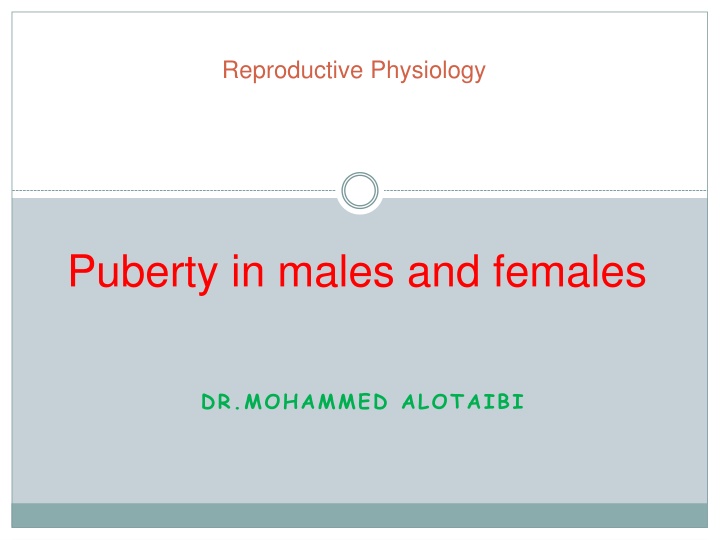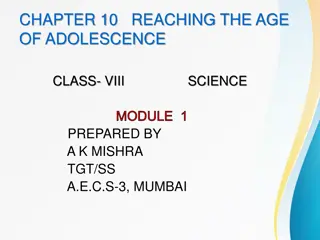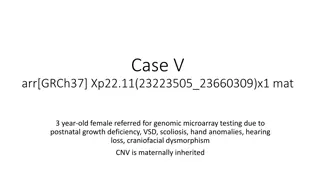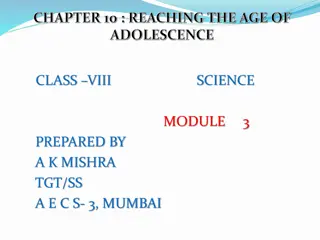
Puberty and Reproductive Physiology Changes in Adolescents
Explore the physiological transition from childhood to adulthood in males and females during puberty. Learn about the hormonal changes, physical developments, and influencing factors associated with this crucial phase of life. Discover the key terms and events related to puberty, including the onset of menstruation and spermatogenesis. By the end of this lecture, you will have a comprehensive understanding of the puberty process and its significance in reproductive health.
Download Presentation

Please find below an Image/Link to download the presentation.
The content on the website is provided AS IS for your information and personal use only. It may not be sold, licensed, or shared on other websites without obtaining consent from the author. If you encounter any issues during the download, it is possible that the publisher has removed the file from their server.
You are allowed to download the files provided on this website for personal or commercial use, subject to the condition that they are used lawfully. All files are the property of their respective owners.
The content on the website is provided AS IS for your information and personal use only. It may not be sold, licensed, or shared on other websites without obtaining consent from the author.
E N D
Presentation Transcript
Reproductive Physiology Puberty in males and females DR.MOHAMMED ALOTAIBI
Objectives By the end of this lecture, you should be able to: Define Puberty Recognize the physiology of puberty related to changes in hypothalamic-pituitary-gonadal axis Describe the physical changes that occur at puberty in boys and girls Recognize the influencing factors leading to puberty Describe the pathophysiological conditions associated with puberty
PUBERTY Definition: Physiological transition from childhood (juvenile) to adulthood. At puberty: The primary sexual organs mature (gonads). The secondary sexual characteristics develop. The adolescent experiences the adolescent growth spurt. The adolescent achieves the ability to procreate.
Pulsatile secretion of GnRH Increased sensitivity of the GnRH receptors in anterior pituitary Pulsatile secretion of LH and FSH Appearance of large nocturnal pulses of LH during REM sleep. Maturation of primary sexual characteristics (gonads) Secretion of gonadal steroid hormones testosterone and estradiol Appearance of the secondary sex characteristics at puberty
Puberty Appearance of secondary sexual characteristics (pubic and axillary hair, female breast development, male voice changes,...) - Menstruation and spermatogenesis begin Occurs between 8 and 14yrs in girls Occurs between 9 and 14yrs in boys
Puberty Terms & Events Thelarche: development of breast Puberache: development of pubic & axillary hair Menarche: the first menstrual period Adrenarche: the onset of an increase in the secretion of androgens; responsible for the development of pubic/axillary hair, body odour and acne. Gonadarche: maturation of gonadal function
Increased sensitivity of the GnRH receptors to very low gonadotropins before puberty
Puberty hormonal changes In young children, low gonadotropins and increased sensitivity of GnRH receptors to low gonadotropins cannot initiate gonadal function Between 9-12 yrs, blood levels of LH, FSH increase. High levels of LH, FSH initiate gonadal development Nocturnal GnRH pulsatility (LH secretion) precedes phenotypic changes by several years First phenotypic changes: breast development / testicular enlargement
Puberty hormonal changes HYPOTHALAMUS GnRH, GHRH, CRH, TRH ANTERIOR PITUITARY LH & FSH TSH ACTH HORMONE HORMONE GROWTH HORMONE TESTIS/ OVARY Thyroid gland Adrenal cortex LIVER SEX STEROID SYNTHESIS Thyroid Cortisol Androgens IGF-1 SEXUAL MATURATION SOMATIC GROWTH TISSUE GROWTH
Physical Changes 5 stages from childhood to full maturity Tanner Scale (1 5) Reflect progression in changes of the external genitalia/breast and pubic hair Secondary sexual characteristics Mean age 11yrs in girls Mean age 11.5 12yrs in boys
Puberty: Girls Thelarche is usually the first sign in most girls. Menarche usually occurs 2-3 yrs after Thelarche. dependent on increased secretion of adrenal androgens (adrenarche). and closure of the epiphyses typically begin and end earlier in girls than in boys.
Puberty: Boys Puberty is associated with activation of the HPG axis. Leydig cell proliferation in the testes, and increased synthesis and secretion of testosterone. There is growth of the testes, largely because of an increased number of seminiferous tubules. There is growth of the sex accessory organs such as the prostate. There is a pronounced linear growth spurt. As plasma levels of testosterone increase, facial, pubic, and axillary hair appears and there is growth of the penis, lowering of the voice, and initiation of spermatogenesis (spermarche).
Physical development (Girls) Physical development (Boys) Stage (Prepubertal). No glandular breast tissue palpable. Just (Prepubertal).Testicular volume < 3 mL. No pubic B1 G1 an elevation of breast papilla. No pubic hair. hair. PH1 PH1 Enlargement of testicular volume (3-6 mL) [1st Breast budding with elevation of breast and papilla as a B2 G2 small mound [1st pubertal sign in girls]. Downy soft pubertal sign in boys]. Little or no change in PH2 PH2 pubic hair. penile size. Downy soft pubic hair. Growth spurt (between stage 2-3) Further enlargement of breast and areola. Darker, Testicular volume 8-12 mL. Penile lengthening. B3 G3 coarser and curled hair. Darker, coarser, and curled hair. PH3 PH3 Growth spurt (between stage 3-4) Projection of areola and papilla to form a double Testicular volume 12-15 mL. Penile lengthening B4 G4 mound above the level of the breast. More dense hair and broadening. Terminal hair that fills the entire PH4 PH4 that fills the entire triangle overlying the pubic region triangle overlying the pubic region and external and external genitalia and no spread to the inner thigh. genitalia and no spread to the inner thigh. Menarche (between stage 4-5) Mature breast. Loss of double mound due to the Testicular volume > 15 mL. Adult genitalia. B5 G5 projection of papilla only and recession of the areola to Terminal hair that extends beyond the inguinal PH5 PH5 the level of the breast. Dense hair that extends beyond area onto the inner thigh. the inguinal area onto the inner thigh.
Puberty Puberty usually completed within 3 - 4 yrs of onset. Timing of puberty describes how mature a child is relative to his/her peers at the same age and sex (early, on time, or delayed). Tempo describes how quickly or slowly a child progresses throughout the stages of puberty to the complete development (slow, average, or fast).
Influencing Factors Genetic factors : 50-80% of variation in pubertal timing. Environmental factors: (Geographical differences, psychosocial stresses, endocrine disruptors from pollutants, and exposure to chemical and industrial compounds). Obesity e.g. Leptin hormone regulates appetite and metabolism through hypothalamus. Permissive role in regulating the timing of puberty. Malnutrition and strenuous physical activity: delay puberty.
Disorders of Puberty Early or Delayed Puberty Precocious Puberty
PRECOCIOUS PUBERTY Precocious onset of puberty is defined as occurring younger than 2 yrs before the average age Girls < 8 years old Boys < 9 years old
(1) Central Precocious Puberty [Gonadotropin-dependent] - - - - Idiopathic central precocious puberty CNS tumours CNS congenital abnormalities Infectious or post-infectious conditions of hypothalamus PRECOCIOUS PUBERTY (2) Pseudoprecocious (Peripheral) Puberty [Gonadotropin-independent] - - - - Congenital adrenal hyperplasia (CAH) Gonads or adrenal gland tumours FSH and LH are suppressed No spermatogenesis or ovarian development
Delayed PUBERTY Initial physical changes of puberty are not present by age 13 years in girls (or primary amenorrhea at 15.5- 16y) by age 14 years in boys Pubertal development is inappropriate - The interval between first signs of puberty and menarche in girls, completion of genital growth in boys is > 5 years
(1) Gonadal Failure Hypergonadotropic hypogonadism: - Turner syndromes - Chemo/radio therapies - Congenital gonadal dysgenesis or Cryptorchidism - FSH, LH and androgen receptor gene mutations - Gonadal damage secondary to trauma, tumours, surgical removal, and infectious or autoimmune diseases. DELAYED PUBERTY (2) Gonadal Deficiency Hypogonadotropic hypogonadism: - Idiopathic - FSH and LH gene mutations from pituitary gonadotropes - Low FSH and LH levels - KiSS-1 or GPR54 gene mutations - CNS congenital anomalies and panhypopituitarism






















